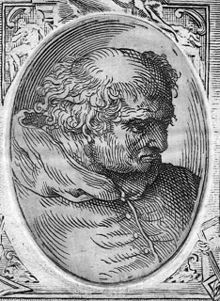art.wikisort.org - Artist
Donato Bramante (UK: /bræˈmænteɪ/ bram-AN-tay,[1] US: /brəˈmɑːnteɪ, -ti/ brə-MAHN-tay, -tee,[2][3] Italian: [doˈnaːto braˈmante]; 1444 – 11 April 1514),[4] born as Donato di Pascuccio d'Antonio[5] and also known as Bramante Lazzari,[6][7] was an Italian architect and painter. He introduced Renaissance architecture to Milan and the High Renaissance style to Rome, where his plan for St. Peter's Basilica formed the basis of design executed by Michelangelo. His Tempietto (San Pietro in Montorio) marked the beginning of the High Renaissance in Rome (1502) when Pope Julius II appointed him to build a sanctuary over the spot where Peter was martyred.
Donato Bramante | |
|---|---|
 Donato Bramante | |
| Born | Donato di Pascuccio d'Antonio 1444 Fermignano, Duchy of Urbino (present-day Italy) |
| Died | 11 April 1514 (aged 69–70) Rome, Papal States (present-day Italy) |
| Nationality | Italian |
| Known for | Architecture, painting |
| Notable work | San Pietro in Montorio |
| Movement | High Renaissance |
Life
Urbino
Bramante was born under the name Donato d'Augnolo,[7] Donato di Pascuccio d'Antonio, or Donato Pascuccio d'Antonio[citation needed] in Fermignano near Urbino. Here, in 1467, Luciano Laurana was adding to the Palazzo Ducale an arcaded courtyard and other Renaissance features to Federico da Montefeltro's ducal palace. Bramante's architecture has eclipsed his painting skills: he knew the painters Melozzo da Forlì and Piero della Francesca well, who were interested in the rules of perspective and illusionistic features in Andrea Mantegna's painting.
Milan
Around 1474, Bramante moved to Milan, a city with a deep Gothic architectural tradition, and built several churches in the new Antique style. The Duke, Ludovico Sforza, made him virtually his court architect, beginning in 1476, with commissions that culminated in the famous trompe-l'œil choir of the church of Santa Maria presso San Satiro (1482–1486).[citation needed] Space was limited, and Bramante made a theatrical apse in bas-relief, combining the painterly arts of perspective with Roman details. There is an octagonal sacristy, surmounted by a dome. In Milan, Bramante also built the tribune of Santa Maria delle Grazie (1492–99); other early works include the Cloisters of Sant'Ambrogio, Milan (1497–1498), and some other constructions in Pavia (where he worked on the Cathedral, setting the design and creating the crypt and part of the apse[8]) and possibly Legnano. However, in 1499, with his Sforza patron driven from Milan by an invading French army, Bramante made his way to Rome, where he was already known to the powerful Cardinal Riario.[citation needed]
Rome

In Rome, he was soon recognized by Cardinal Della Rovere, shortly to become Pope Julius II. For Ferdinand of Aragon and Isabella of Castile or possibly Julius II, Bramante designed one of the most harmonious buildings of the Renaissance: the Tempietto (1502) of San Pietro in Montorio on the Janiculum.[9] Despite its small scale, the construction has all the rigorous proportions and symmetry of Classical structures, surrounded by slender Doric columns, surmounted by a dome. According to a later engraving by Sebastiano Serlio, Bramante planned to set it within a colonnaded courtyard. In November 1503, Julius engaged Bramante for the construction of the grandest European architectural commission of the 16th century, the complete rebuilding of St Peter's Basilica. The cornerstone of the first of the great piers of the crossing was laid with ceremony on 17 April 1506. Very few drawings by Bramante survive, though some by his assistants do, demonstrating the extent of the team which had been assembled. Bramante's vision for St Peter's, a centralized Greek cross plan that symbolized sublime perfection for him and his generation (compare Santa Maria della Consolazione at Todi, influenced by Bramante's work) was fundamentally altered by the extension of the nave after his death in 1514. Bramante's plan envisaged four great chapels filling the corner spaces between the equal transepts, each one capped with a smaller dome surrounding the great dome over the crossing. So Bramante's original plan was very much more Romano-Byzantine in its forms than the basilica that was actually built. (See St Peter's Basilica for further details.)[citation needed]
Bramante also worked on several other commissions. Among his earliest works in Rome, before the Basilica's construction was under way, is the cloister (1500–1504) of Santa Maria della Pace near Piazza Navona.[citation needed]
Works
This list is incomplete; you can help by adding missing items. (June 2016) |
- Santa Maria presso San Satiro, Milan, ca. 1482–1486
- Santa Maria delle Grazie (cloister and apse); Milan, 1492–1498
- The Tempietto, San Pietro in Montorio, Rome, 1502
- Santa Maria della Pace (cloister); Rome, 1504
- St. Peter's Basilica, Rome, design 1503, ground breaking 1506
- Cortile del Belvedere, Vatican City, Rome, 1506.
- Palazzo Caprini (also known as Raphael's House), Rome, started around 1510 (demolished in the 17th century)
In addition to building, Bramante wrote about architecture and composed eighty sonnets.[10]
See also
References
- "Bramante, Donato". Lexico UK English Dictionary. Oxford University Press. Archived from the original on 24 October 2020.
- "Bramante". The American Heritage Dictionary of the English Language (5th ed.). HarperCollins. Retrieved 13 August 2019.
- "Bramante". Merriam-Webster Dictionary. Retrieved 13 August 2019.
- Davies, Paul; Hemsoll, David (1996). "Bramante, Donato". In Turner, Jane (ed.). The Dictionary of Art. Vol. IV. New York: Grove. pp. 642–653. ISBN 9781884446009.
- Forsyth, Joseph (2001). Remarks on Antiquities, Arts, and Letters During an Excursion in Italy, in the Years 1802 and 1803. University of Delaware Press. p. 289.
- Baynes, T. S., ed. (1878), , Encyclopædia Britannica, vol. 4 (9th ed.), New York: Charles Scribner's Sons, pp. 213–14
- Chisholm, Hugh, ed. (1911), , Encyclopædia Britannica, vol. 4 (11th ed.), Cambridge University Press, p. 418
- "Duomo di Pavia". Lombardia Beni Culturali. Retrieved 30 July 2022.
- Freiberg, Jack (2014). Bramante's Tempietto, the Roman Renaissance, and the Spanish Crown. Cambridge University Press. ISBN 978-1-107-04297-1.
- Weigert, Hans (1961). Busch, Harald; Lohse, Bernd (eds.). Buildings of Europe: Renaissance Europe. New York: The Macmillan Company. p. ix.
External links
- Donato Bramante - World History Encyclopedia
- Sauer, Joseph (1907). . Catholic Encyclopedia. Vol. 2.
- Donato Bramante Source Information, Pictures & Documentaries about Donato.
На других языках
[de] Donato Bramante
Donato Bramante, eigentlich Donato di Pascuccio d’Antonio (* 1444 in Fermignano; † 11. April 1514[1] in Rom), war ein italienischer Maler, Baumeister und Begründer der Hochrenaissance-Architektur. Vom Großvater mütterlicherseits erhielt er den Beinamen Bramante, was „der Begehrende“ bedeutet (italienisch bramare = „heftig begehren“).- [en] Donato Bramante
[es] Donato d'Angelo Bramante
Donato di Pascuccio d'Antonio o Donato di Angelo di Antonio, conocido como Bramante (Fermignano, c. 1443/1444-Roma, 1514), fue un pintor y arquitecto italiano, que introdujo el estilo del primer Renacimiento en Milán y el «Alto Renacimiento» en Roma, donde su obra más famosa fue el planeamiento de la Basílica de San Pedro.[fr] Bramante
Donato « Donnino » di Angelo di Pascuccio dit Bramante, est né en 1444 à Fermignano (anciennement Monte Asdrualdo) près de la cité d'Urbino dans l'actuelle région des Marches en Italie et mort le 11 avril 1514 à Rome.[it] Bramante
Donato "Donnino" di Angelo di Pascuccio, detto il Bramante e conosciuto anche come Donato Bramante (Fermignano, 1444[1] – Roma, 11 aprile 1514[2]), è stato un architetto e pittore italiano, tra i maggiori artisti del Rinascimento. Formatosi a Urbino, uno dei centri della cultura italiana del XV secolo, fu attivo dapprima a Milano, condizionando lo sviluppo del rinascimento lombardo, quindi a Roma, dove progettò la basilica di San Pietro. In qualità di architetto, fu la personalità di maggior rilievo nel passaggio tra il XV e il XVI secolo e nel maturare del classicismo cinquecentesco, tanto che la sua opera è confrontata dai contemporanei all'architettura delle vestigia romane[3] e lui considerato "inventore luce della buona e vera Architettura".[4][ru] Браманте, Донато
Донато Браманте (итал. Donato (Donnino) di Pascuccio di Antonio detto il Bramante; 1444, Ферминьяно — 11 апреля[1] 1514, Рим) — итальянский архитектор и художник, крупнейший представитель архитектуры эпохи Высокого Возрождения, основоположник стилистического течения, именуемого римским классицизмом начала XVI века. Его самыми известными работами являются: первый проект главного храма западного христианства — собора Святого Петра в Ватикане (был перестроен в последующие годы), частично сохранившийся дворец Бельведер (также в Ватикане), храм Темпьетто в Риме, перестройка церкви Санта-Мария-прессо-Сан-Сатиро в Милане и некоторые другие. Как художник, Браманте является автором нескольких сохранившихся до наших дней живописных работ.Другой контент может иметь иную лицензию. Перед использованием материалов сайта WikiSort.org внимательно изучите правила лицензирования конкретных элементов наполнения сайта.
WikiSort.org - проект по пересортировке и дополнению контента Википедии


